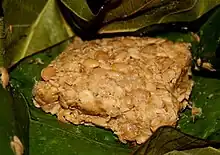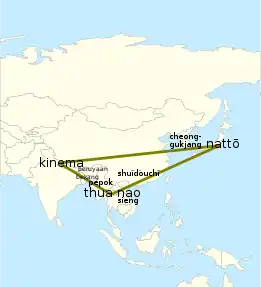 Kinema on a traditional leaf wrapping | |
| Alternative names | Chembihik, Hokuma , Goyang, Ghogima, |
|---|---|
| Type | Fermented food |
| Place of origin | Nepal |
| Region or state | Nepal, India (Sikkim, Darjeeling, Kalimpong), Bhutan |
| Created by | kirat people |
| Main ingredients | Soybean fermented by Bacillus subtilis[1] |
Kinema (Nepali: किनेमा) is a fermented soybean food, prepared by the Nepali communities of the Eastern Himalayas region: Eastern Nepal, and Darjeeling, Kalimpong and Sikkim regions of India.[2] Kinema also known as Kinama, which is a traditional food of the Kirati people
Etymology and history
The word kinema is believed to be derived from the Kirati people kinama, where ki means fermented and nama means to smell.[3] It is a traditional food of the Kirati people.[4]
According to Indian microbiologist Jyoti Prakash Tamang, kinema is estimated to have originated around 600 BC to 100 AD during Kirat dynasty rule, introduced by Limbu people.[5]
Tales of Kinama
Hetchhakuppa and Wahilungma were living happily by hunting and eating Dioscorea bulbifera (गिठ्ठाभ्याकुर) from the forest. At that time, there was a big drought, and their lives became more difficult. One day, Hetchhakuppa killed a pair of Sabudukuiwa (pigeons). After eating the meat, the remaining satbiu palbiu grain in the crop is thrown into the drainage.
After a long time, those grains start to grow, bloom, and even begin to bear fruit, according to time. Because of scarcity, Hetchhakuppa and Walilungma starts eating the grown grains; their health is gradually degraded when they eat them, and they remember that they should eat only after worshipping their ancestors first. It is said that the Chachhuwa Puja (चाछुवा) started after that. During the Chachhuwa Puja, freshly prepared phengkuwa (चिउरा) is always required.
Soon, Hetchhakuppa and Wahilungma's bodies get stronger, and their wealth will also increase. Meanwhile, Momihang from the neighbouring village starts playing tricks on Hetchhakuppa. One day Momihang asked Hetchhakuppa, 'Hetchakuppa, you don't even go hunting; you don't even go to look for yam; how are you so strong?' That's how Hetchhakuppa revealed the secret of his eating habits. In the end, he asked Hetchhakuppa for grain seeds. Hetchhakuppa remembered Momihang's atrocities, so he roasted all the seeds and sent them to Momihang.
Momihang took the seeds there and scattered them all over the fields, but the seeds did not grow. Momihang became very angry when he realises that Hetchhakuppa is making a fool of him by giving him fried grain. After that, Momihang gathered up all those who were on his side and attacked Hetchhakuppa. Hetchhakuppa and Wahilungma run to save their lives, leaving the soybeans that were boiling in the pot. After 3/4 days, Hetchhakuppa and Wahilungma returned, but Momihang had already looted. There was nothing but the burning soybeans. When they open it, a craving smell comes from it. So, this is how it became the most popular dish among the Rai tribes.
Ki (ferment)
Nama (to smell)
Source - Harka Bahadur Rungmanghang 93, Bhojpure, Dilpa
Production
The first step of kinema production is soaking soybeans overnight. The soaked beans are boiled until soft (2–3 hours). Water is drained off and beans are lightly cracked with a mortar. 1% of firewood ash is added and mixed thoroughly. The grits are put in a bamboo bucket lined with local fern (Glaphylopteriolopsis erubescens). The bucket is covered with a jute bag and left to ferment naturally at ambient temperatures for 1–3 days.[2]
No bacterial culture is intentionally added to kinema. Successful fermentation relies on natural bacteria, mainly Bacillus subtilis.[1]
Consumption
The slimy, odorous product of fermentation is traditionally prepared into a soup that is consumed with rice, but can also be turned into a savoury dip or a pungent side dish to be consumed along with rice or bread. Kinema is traditionally prepared at home, but now it is sold in local markets and even retailed online as a dried product.
Nutritional value
| Nutritional value per 100 g (3.5 oz) | |
|---|---|
| Energy | 2,000 kJ (480 kcal) |
28g | |
17g | |
48g | |
| |
| †Percentages are roughly approximated using US recommendations for adults. | |
Kinema is considered a healthy food because fermentation breaks down complex proteins into easily digestible amino acids.[7] The product is alkaline with pH of 7.89, unlike soyabean which has a pH of 6.75. It has 62% moisture content. 48 g of protein, 28 g of carbohydrate, 17 g of fat and 7 g of ash is found in every 100 g of dry kinema. The energy value of Kinema is 2 MJ per 100 grams. Free fatty acidity in kinema is found to be about 33 times higher than raw soybeans.[8]
Similar foods

Many other Asian countries have Bacillus-fermented soyabean dishes, such as shuǐdòuchǐ of China, cheonggukjang of Korea, nattō of Japan, thua nao of Thailand, tungrymbai of Meghalaya, hawaijaar of Manipur, bekangum of Mizoram, akhuni of Nagaland, and piak of Arunachal Pradesh, India.[9]
Kinema forms one of the vertices of the "natto triangle" proposed by the Japanese ethnobiologist Sasuke Nakao. Jyoti Prakash Tamang proposed a extended ‘KNT (Kinema-Natto-Thua Nao) triangle', connecting the fermented soyabeans across Asia.[2] Nakao hypothesized Yunnan region of China to be the origin place of fermented soyabean technique, as the center of the triangle falls in that region.[10] Jyoti Prakash Tamang shows evidence that fermented soybean styles in India all derive from kinema.[2]
See also
References
- 1 2 Kharnaior, P; Tamang, JP (2022). "Metagenomic-Metabolomic Mining of Kinema, a Naturally Fermented Soybean Food of the Eastern Himalayas". Frontiers in Microbiology. 13: 868383. doi:10.3389/fmicb.2022.868383. PMC 9106393. PMID 35572705.
- 1 2 3 4 Tamang, Jyoti Prakash (March 2015). "Naturally fermented ethnic soybean foods of India". Journal of Ethnic Foods. 2 (1): 8–17. doi:10.1016/j.jef.2015.02.003.
- ↑ "Kinema—fermented flavours of Kirats and its history". kathmandupost.com. Retrieved 2022-02-14.
- ↑ Tamang, Prescilla (2020-07-08). "Axone: The Problematic Representation Of The Nepali Community In The Film". Feminism In India. Retrieved 2022-02-14.
- ↑ "Kinema—fermented flavours of Kirats and its history". kathmandupost.com. Retrieved 2022-02-14.
- ↑ "KINEMA". TRADITIONAL FERMENTED FOODS AND BEVERAGES OF THE SIKKIM HIMALAYAS.
- ↑ KARKI, ANSUHA (2021-07-05). "Traditional food". The Himalayan Times. Retrieved 2022-02-14.
- ↑ Sarkar, P. K.; Tamang, J. P.; Cook, P. E.; Owens, J. D. (1994-02-01). "Kinema — a traditional soybean fermented food: proximate composition and microflora". Food Microbiology. 11 (1): 47–55. doi:10.1006/fmic.1994.1007. ISSN 0740-0020.
- ↑ "History of Natto and Its Relatives (1405-2012) - SoyInfo Center". www.soyinfocenter.com. Retrieved 2022-02-14.
- ↑ Shurtleff, William; Aoyagi, Akiko (December 2010). History of Soybeans and Soyfoods in South Asia / Indian Subcontinent (1656-2010): Extensively Annotated Bibliography and Sourcebook. Soyinfo Center. ISBN 978-1-928914-31-0.
